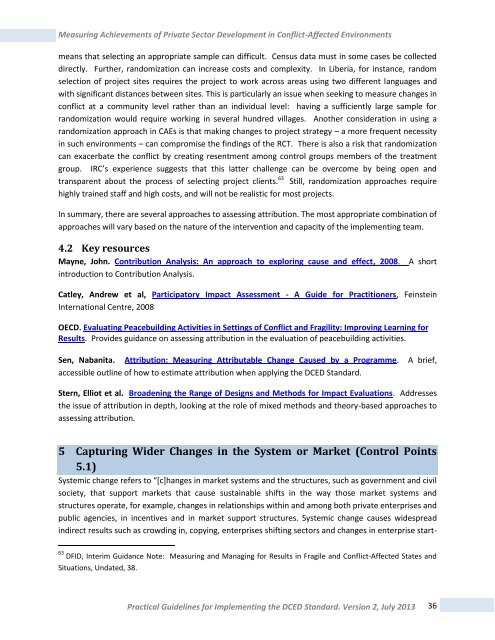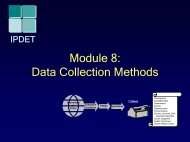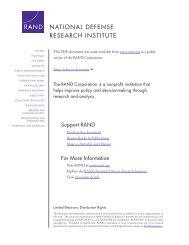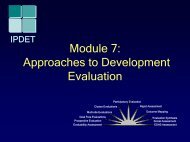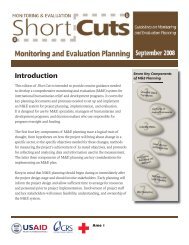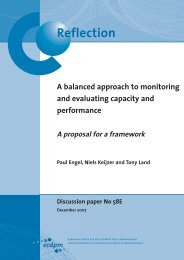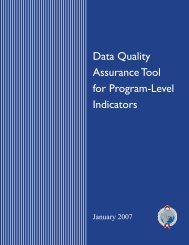Measuring Achievements of Private Sector Development in ... - DCED
Measuring Achievements of Private Sector Development in ... - DCED
Measuring Achievements of Private Sector Development in ... - DCED
Create successful ePaper yourself
Turn your PDF publications into a flip-book with our unique Google optimized e-Paper software.
<strong>Measur<strong>in</strong>g</strong> <strong>Achievements</strong> <strong>of</strong> <strong>Private</strong> <strong>Sector</strong> <strong>Development</strong> <strong>in</strong> Conflict-Affected Environments<br />
means that select<strong>in</strong>g an appropriate sample can difficult. Census data must <strong>in</strong> some cases be collected<br />
directly. Further, randomization can <strong>in</strong>crease costs and complexity. In Liberia, for <strong>in</strong>stance, random<br />
selection <strong>of</strong> project sites requires the project to work across areas us<strong>in</strong>g two different languages and<br />
with significant distances between sites. This is particularly an issue when seek<strong>in</strong>g to measure changes <strong>in</strong><br />
conflict at a community level rather than an <strong>in</strong>dividual level: hav<strong>in</strong>g a sufficiently large sample for<br />
randomization would require work<strong>in</strong>g <strong>in</strong> several hundred villages. Another consideration <strong>in</strong> us<strong>in</strong>g a<br />
randomization approach <strong>in</strong> CAEs is that mak<strong>in</strong>g changes to project strategy – a more frequent necessity<br />
<strong>in</strong> such environments – can compromise the f<strong>in</strong>d<strong>in</strong>gs <strong>of</strong> the RCT. There is also a risk that randomization<br />
can exacerbate the conflict by creat<strong>in</strong>g resentment among control groups members <strong>of</strong> the treatment<br />
group. IRC’s experience suggests that this latter challenge can be overcome by be<strong>in</strong>g open and<br />
transparent about the process <strong>of</strong> select<strong>in</strong>g project clients. 63 Still, randomization approaches require<br />
highly tra<strong>in</strong>ed staff and high costs, and will not be realistic for most projects.<br />
In summary, there are several approaches to assess<strong>in</strong>g attribution. The most appropriate comb<strong>in</strong>ation <strong>of</strong><br />
approaches will vary based on the nature <strong>of</strong> the <strong>in</strong>tervention and capacity <strong>of</strong> the implement<strong>in</strong>g team.<br />
4.2 Key resources<br />
Mayne, John. Contribution Analysis: An approach to explor<strong>in</strong>g cause and effect, 2008.<br />
<strong>in</strong>troduction to Contribution Analysis.<br />
A short<br />
Catley, Andrew et al, Participatory Impact Assessment - A Guide for Practitioners, Fe<strong>in</strong>ste<strong>in</strong><br />
International Centre, 2008<br />
OECD. Evaluat<strong>in</strong>g Peacebuild<strong>in</strong>g Activities <strong>in</strong> Sett<strong>in</strong>gs <strong>of</strong> Conflict and Fragility: Improv<strong>in</strong>g Learn<strong>in</strong>g for<br />
Results. Provides guidance on assess<strong>in</strong>g attribution <strong>in</strong> the evaluation <strong>of</strong> peacebuild<strong>in</strong>g activities.<br />
Sen, Nabanita. Attribution: <strong>Measur<strong>in</strong>g</strong> Attributable Change Caused by a Programme. A brief,<br />
accessible outl<strong>in</strong>e <strong>of</strong> how to estimate attribution when apply<strong>in</strong>g the <strong>DCED</strong> Standard.<br />
Stern, Elliot et al. Broaden<strong>in</strong>g the Range <strong>of</strong> Designs and Methods for Impact Evaluations. Addresses<br />
the issue <strong>of</strong> attribution <strong>in</strong> depth, look<strong>in</strong>g at the role <strong>of</strong> mixed methods and theory-based approaches to<br />
assess<strong>in</strong>g attribution.<br />
5 Captur<strong>in</strong>g Wider Changes <strong>in</strong> the System or Market (Control Po<strong>in</strong>ts<br />
5.1)<br />
Systemic change refers to “[c]hanges <strong>in</strong> market systems and the structures, such as government and civil<br />
society, that support markets that cause susta<strong>in</strong>able shifts <strong>in</strong> the way those market systems and<br />
structures operate, for example, changes <strong>in</strong> relationships with<strong>in</strong> and among both private enterprises and<br />
public agencies, <strong>in</strong> <strong>in</strong>centives and <strong>in</strong> market support structures. Systemic change causes widespread<br />
<strong>in</strong>direct results such as crowd<strong>in</strong>g <strong>in</strong>, copy<strong>in</strong>g, enterprises shift<strong>in</strong>g sectors and changes <strong>in</strong> enterprise start-<br />
63 DFID, Interim Guidance Note: <strong>Measur<strong>in</strong>g</strong> and Manag<strong>in</strong>g for Results <strong>in</strong> Fragile and Conflict-Affected States and<br />
Situations, Undated, 38.<br />
Practical Guidel<strong>in</strong>es for Implement<strong>in</strong>g the <strong>DCED</strong> Standard. Version 2, July 2013<br />
36


